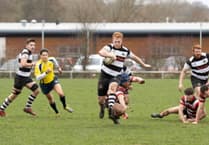IN THIS series on different sports that take place in Farnham, we’ll now turn to the game with the oval ball – rugby union.
There is a plaque on the wall at Rugby School which reads: This stone commemorates the exploit of William Webb Ellis who, with a fine disregard for the rules of football as played in his time, first took the ball in his arms and ran with it, thus originating the distinctive feature of the rugby game. AD 1823.
It’s the source of one of the best-known stories of English sport, so well known that the rugby World Cup today is called the William Webb Ellis Trophy.
But evidence for this story – that a schoolboy invented rugby by picking up and running with the ball during a football match – is sketchy to say the least.
At the start of the 19th century a number of public schools – including Rugby – were playing a version of football, all with slightly different rules, though it was normally permissible to catch the ball to kick it. In the 1820s, boys at Rugby School began running with the ball in hand, and this gradually became an integral part of their game.
In 1863 the Football Association was formed to standardise the laws of the game.
Running carrying the ball was outlawed -- but Rugby School carried on with its own version of ‘rugby football.’
Mainly through the influence of former pupils who introduced it where they lived and worked, soon ‘rugby clubs’ were being established throughout Britain and the colonies.
But there was still variations in the rules.
In 1871 a meeting was held in London with 21 rugby clubs represented and the Rugby Football Union (RFU) was established and subsequently the first set of unified laws of the game were drawn up.
For historians of sport, the most interesting aspect of the development of the sport of rugby is the fascinating divide between the codes of rugby union and rugby league, and it’s mainly to do with money.
In 1895, the RFU voted against the payment of players for ‘broken time’ – for lost earnings – while playing, so the 22 northern clubs broke away to form the Northern Union, and allowed its players to be paid.
They also introduced changes to the laws of the game which eventually became rugby league.
The union authorities determinedly defended the concept of amateurism, imposing draconian penalties – including life bans – on any player who had anything to do with the professional game.
It wasn’t until 1995, a century after the original split, that the International Rugby Board bowed to the inevitable and accepted union players could be paid.
Long before England rugby’s stadium at Twickenham, that opened in 1909, came on to the scene, Kennington Oval was, briefly, the centre of attention for cricket, rugby union and football.
Used as a cricket ground since 1845, the Oval staged the first rugby international in 1872, the same season it was host to the first Football Association Cup Final.
These days, the rugby Six Nations Championship is one of the biggest, best and most dramatic tournaments in the sporting calendar.
Setting aside the rugby World Cup, which is held every four years, the annual Six Nations is probably the most revered event in world rugby.
Of course, we have to highlight England’s finest rugby achievement, which happened in 2003. Who can forget one of the most famous moments in world rugby when Jonny Wilkinson scored a drop goal in the last minute of extra time to give England a last-gasp win against Australia in the 2003 World Cup Final.
The Farnham Rugby Union Football Club is a relatively new club to the town compared to other sports, but fortunately for residents, it just so happens they’re a first-rate community club with a large youth section.
High up on their achievements are the acquisition of an impressive new ground, opened by England rugby hero, Jonny Wilkinson, who honed his skills at Farnham at youth level, and the club’s first XV who won a national club competition, the Senior Vase Final, at Twickenham in 2017.
The game is somewhat at a crossroads at the moment. The break for the coronavirus pandemic has further fuelled a few challenges for the rugby authorities, and the nature of the game – there is arguably more close contact in rugby than in just about any other sport – makes it tougher to know when and how it will be ready to resume.
But it’s a wonderfully exciting team sport to play and watch so let’s hope normal rugby service at all levels resumes soon...




